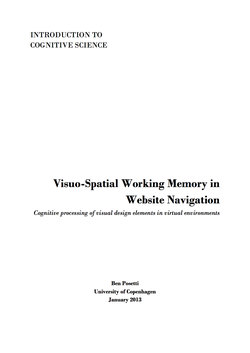Introduction to Cognitive Science

Реклама. ООО «ЛитРес», ИНН: 7719571260.
Оглавление
Ben Posetti. Introduction to Cognitive Science
1. INTRODUCTION
2. WORKING MEMORY. 2.1 Working memory in human cognition
2.2 Visuo-spatial working memory
2.3 Relevant findings in Visuo-Spatial Working Memory
i) Similarity effects
ii) Order effects
iii) Complexity and structure
iv) Rehearsal mechanisms
v) Landmarks
vi) Lateralised bias
vii) Visual input encoding
3. VISUAL AND SPATIAL WEB DESIGN. 3.1 Introduction to web design
3.2 Relating Visuo-Spatial Working Memory and Usability
4. VISUO-SPATIAL PROCESSING OF WEBSITES
4.1 Typography and text
4.2 Maps and graphs
4.3 Schematic drawings
4.4 Pictures
4.5 Node-and-link diagrams
4.6 Icons and symbols
4.7 Visual metaphor
4.8 Visitnorway.com
5. CONCLUSION
APPENDICES. Appendix 1: Usability
Appendix 2: Typography & text
Appendix 3: Graphs and maps
Appendix 4: Schematic Drawings
Appendix 5: Pictures
Appendix 6: Node-and-link diagrams
Appendix 7: Icons and symbols
Appendix 8: Visual Metaphor
Appendix 9: visitnorway.com
Отрывок из книги
Visuo-Spatial Working Memory (VSWM) is the feature of cognitive working memory that temporarily stores and manipulates visuo-spatial input for use in processing (Logie, 1995). The concept was devised as a part of the Baddeley and Hitch (1974) original conception of working memory which entailed three elements: The visuo-spatial sketchpad which performs the functions of VSWM; the phonological loop performing a similar task for verbal (as opposed to visuo-spatial) material; and the central executive handling reasoning, decision making and coordinating the other two elements (Logie, 1995).
VSWM is a fundamental part of human cognition. It is involved in basic human tasks that use visual inputs such as body movements in space or navigation by mental mapping as well as basic processing of immediate visual stimuli. The thesis of this paper is that principles of VSWM can be applied to analyse cognitive load of individuals navigating in websites.
.....
Other results suggest that a cognitive spatial element is involved. Van Hooijdonk, Maes and Ummelen (2006) analysed users use of spatial verbalisations such as “There is more information behind this hyperlink” while cognitively processing websites being navigated. Vörös, Rouet and Pléh (2009b) also found that users with a high spatial capacity more accurately mapped a website than those with low spatial capacity.
This paper will discuss the processing of websites as a source of visuo-spatial input, within a visuo-spatial working memory paradigm. Considering some interesting findings on the architecture of VSWM, I will analyse how visual features are used in websites and reflect on what that means for visuo-spatial cognitive processing and overall website usability. This analysis will be rendered based on principles of visual representation in a HCI context, with examples of how those principles play out in navigation of actual websites.
.....